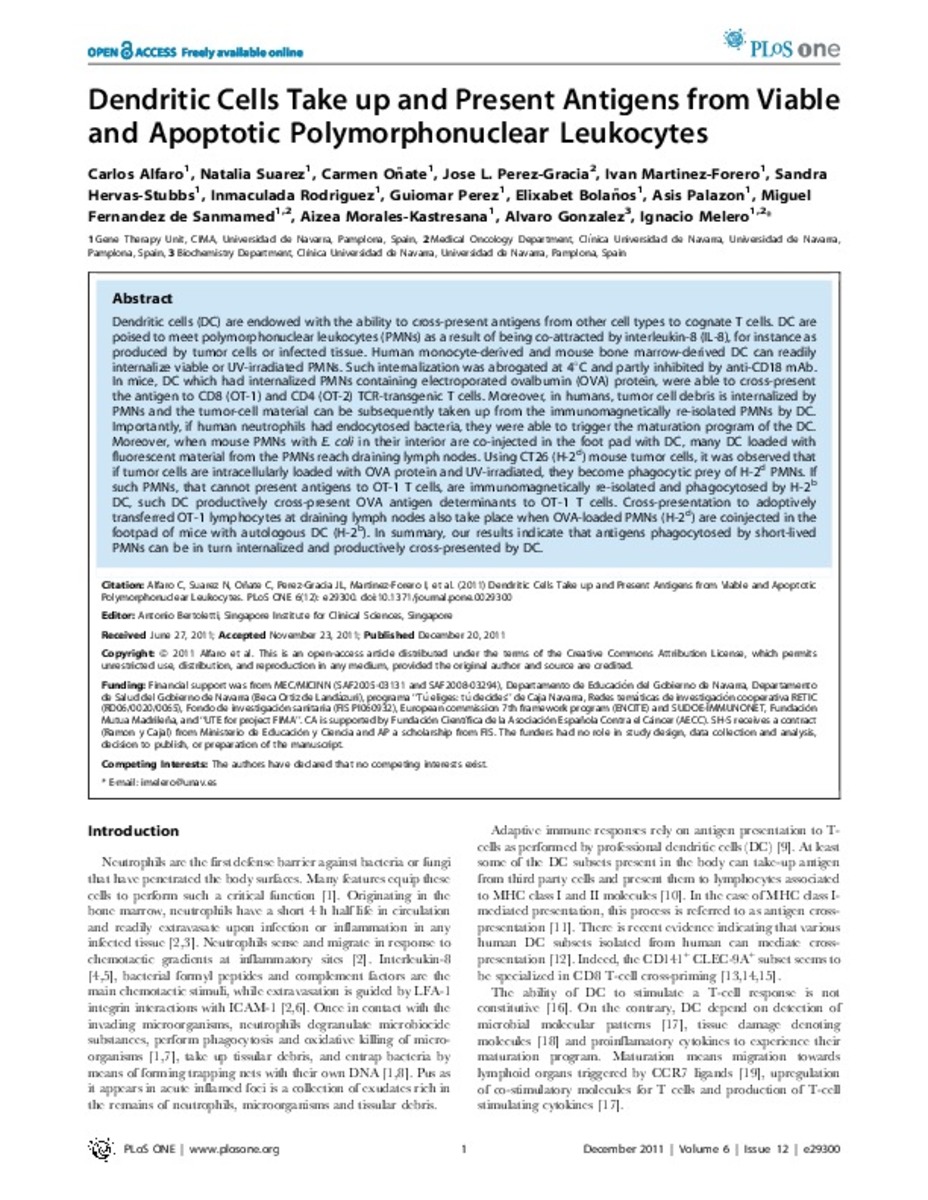Full metadata record
| DC Field | Value | Language |
|---|---|---|
| dc.creator | Alfaro, C. (Carlos) | - |
| dc.creator | Suarez, N. (Natalia) | - |
| dc.creator | Oñate, C. (Carmen) | - |
| dc.creator | Perez-Gracia, J.L. (Jose Luis) | - |
| dc.creator | Martinez-Forero, I. (Iván) | - |
| dc.creator | Hervas-Stubbs, S. (Sandra) | - |
| dc.creator | Rodriguez, I. (Inmaculada) | - |
| dc.creator | Perez, G. (Guiomar) | - |
| dc.creator | Bolaños, E. (Elixabet) | - |
| dc.creator | Palazon, A. (Asís) | - |
| dc.creator | Fernandez-Sanmamed, M. (Miguel) | - |
| dc.creator | Morales-Kastresana, A. (Aizea) | - |
| dc.creator | Gonzalez-Hernandez, A. (Alvaro) | - |
| dc.creator | Melero, I. (Ignacio) | - |
| dc.date.accessioned | 2012-01-02T12:44:45Z | - |
| dc.date.available | 2012-01-02T12:44:45Z | - |
| dc.date.issued | 2011 | - |
| dc.identifier.citation | Alfaro C, Suarez N, Onate C, Perez-Gracia JL, Martinez-Forero I, Hervas-Stubbs S, et al. Dendritic cells take up and present antigens from viable and apoptotic polymorphonuclear leukocytes. PLoS One 2011;6(12):e29300. | es_ES |
| dc.identifier.issn | 1932-6203 | - |
| dc.identifier.uri | https://hdl.handle.net/10171/20369 | - |
| dc.description.abstract | Dendritic cells (DC) are endowed with the ability to cross-present antigens from other cell types to cognate T cells. DC are poised to meet polymorphonuclear leukocytes (PMNs) as a result of being co-attracted by interleukin-8 (IL-8), for instance as produced by tumor cells or infected tissue. Human monocyte-derived and mouse bone marrow-derived DC can readily internalize viable or UV-irradiated PMNs. Such internalization was abrogated at 4°C and partly inhibited by anti-CD18 mAb. In mice, DC which had internalized PMNs containing electroporated ovalbumin (OVA) protein, were able to cross-present the antigen to CD8 (OT-1) and CD4 (OT-2) TCR-transgenic T cells. Moreover, in humans, tumor cell debris is internalized by PMNs and the tumor-cell material can be subsequently taken up from the immunomagnetically re-isolated PMNs by DC. Importantly, if human neutrophils had endocytosed bacteria, they were able to trigger the maturation program of the DC. Moreover, when mouse PMNs with E. coli in their interior are co-injected in the foot pad with DC, many DC loaded with fluorescent material from the PMNs reach draining lymph nodes. Using CT26 (H-2(d)) mouse tumor cells, it was observed that if tumor cells are intracellularly loaded with OVA protein and UV-irradiated, they become phagocytic prey of H-2(d) PMNs. If such PMNs, that cannot present antigens to OT-1 T cells, are immunomagnetically re-isolated and phagocytosed by H-2(b) DC, such DC productively cross-present OVA antigen determinants to OT-1 T cells. Cross-presentation to adoptively transferred OT-1 lymphocytes at draining lymph nodes also take place when OVA-loaded PMNs (H-2(d)) are coinjected in the footpad of mice with autologous DC (H-2(b)). In summary, our results indicate that antigens phagocytosed by short-lived PMNs can be in turn internalized and productively cross-presented by DC. | es_ES |
| dc.language.iso | eng | es_ES |
| dc.publisher | Public Library of Science | es_ES |
| dc.relation | info:eu-repo/grantAgreement/EC/FP7/201032 | - |
| dc.rights | info:eu-repo/semantics/openAccess | es_ES |
| dc.subject | Dendritic cells | es_ES |
| dc.subject | Polymorphonuclear leukocytes | es_ES |
| dc.title | Dendritic cells take up and present antigens from viable and apoptotic polymorphonuclear leukocytes | es_ES |
| dc.type | info:eu-repo/semantics/article | es_ES |
| dc.relation.publisherversion | http://bit.ly/sjuysu | es_ES |
| dc.type.driver | info:eu-repo/semantics/article | es_ES |
Files in This Item:
Statistics and impact
Items in Dadun are protected by copyright, with all rights reserved, unless otherwise indicated.






